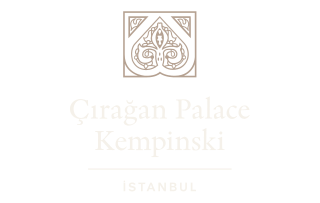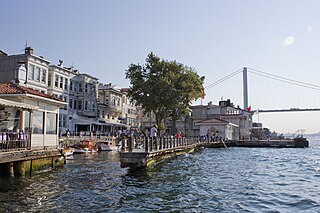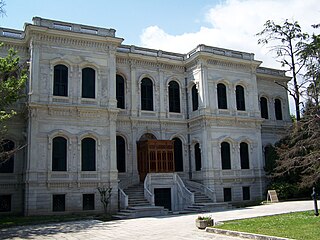
The Topkapı Palace, or the Seraglio, is a large museum and library in the east of the Fatih district of Istanbul in Turkey. From the 1460s to the completion of Dolmabahçe Palace in 1856, it served as the administrative center of the Ottoman Empire, and was the main residence of its sultans.

Dolmabahçe Palace located in the Beşiktaş district of Istanbul, Turkey, on the European coast of the Bosporus strait, served as the main administrative center of the Ottoman Empire from 1856 to 1887 and from 1909 to 1922.

Ahmed Shefik Midhat Pasha was an Ottoman politician, reformist, and statesman. He was the author of the Constitution of the Ottoman Empire.

Çırağan Palace, a former Ottoman palace, is now a five-star hotel in the Kempinski Hotels chain. It is located on the European shore of the Bosporus, between Beşiktaş and Ortaköy in Istanbul, Turkey.

Beylerbeyi is a neighbourhood in the municipality and district of Üsküdar, Istanbul Province, Turkey. Its population is 5,168 (2022). It is located on the Asian shore of the Bosporus, to the north of the Bosphorus Bridge. It is bordered on the northeast by the neighborhood of Çengelköy, on the east by Kirazlıtepe, on the southeast by Küplüce, on the south by Burhaniye, on the southwest by Kuzguncuk, and on the northwest by the Bosporus. Directly across the Bosporus is the Ortaköy neighborhood of Istanbul's Beşiktaş municipality.

The Balyan family was a prominent Armenian family in the Ottoman Empire of court architects in the service of Ottoman sultans and other members of the Ottoman dynasty during the 18th and 19th centuries. For five generations, they designed and constructed numerous major buildings in the Ottoman Empire, including palaces, mansions, konaks, kiosks, yalis, mosques, churches, and various public buildings, mostly in Constantinople.

Küçüksu Pavilion, Littlewater Pavilion a.k.a. Göksu (Skywater) Pavilion, is a summer pavilion in Istanbul, Turkey, situated in the Küçüksu neighborhood of Beykoz district on the Asian shore of the Bosphorus between Anadoluhisarı and the Fatih Sultan Mehmet Bridge. The pavilion was used by Ottoman sultans for short stays during country excursions and hunting.

Dolmabahçe Clock Tower is a clock tower situated outside Dolmabahçe Palace in Istanbul, Turkey. Its construction was ordered by Ottoman sultan Abdülhamid II (1842–1918) and designed by the court architect Sarkis Balyan between 1890 and 1895.

Yıldız is a neighbourhood in the municipality and district of Beşiktaş, Istanbul Province, Turkey. Its population is 5,385 (2022). The neighbourhood comprises some of Istanbul's well known historical locations, such as Yıldız Park and Yıldız Palace, the second-largest palace in Istanbul.

Yıldız Palace is a vast complex of former imperial Ottoman pavilions and villas in Beşiktaş, Istanbul, Turkey, built in the 19th and early 20th centuries. It was used as a residence by the sultan and his court in the late 19th century.

Yıldız Park is a historical, urban park in Beşiktaş district of Istanbul, Turkey. It is one of the largest public parks in Istanbul. The park is located in Yıldız quarter between the palaces of Yıldız and Çırağan.

The Touring and Automobile Club of Turkey (TTOK), also known as Turkish Automobile Association, is an amateur and international organization dedicated to tourism and the automobile sector. It was founded in 1923 at the behest of Mustafa Kemal Atatürk by a group of intellectuals led by Reşit Saffet Atabinen, a diplomat at the time and a historian. The club is a member of Fédération Internationale de l'Automobile (FIA) and Alliance Internationale de Tourisme (AIT).

The Basketmakers' Kiosk, also known as Basketmakers' Palace, named after the Sepetçiler Roma, is a former Ottoman pleasure palace located on the southern shore of Golden Horn's mouth at Sarayburnu in the neighborhood of Sirkeci in Istanbul, Turkey.

The Khedive's Palace, also known as Çubuklu Palace, is located on the Asian side of the Bosphorus in Istanbul, Turkey, and was once the residence of Khedive Abbas II of Egypt and Sudan. In English it is also known as the Khedive's Pavilion or the Khedive's Mansion.
Çelik Gülersoy was a Turkish lawyer, historical preservationist, writer and poet. He is best remembered for the heritage conservation works he carried out on historical sites during his long-time tenure as director general of the Touring and Automobile Club of Turkey (TTOK).

The Emirgan Park is a historical urban park located at the Emirgan neighbourhood in the Sarıyer district of Istanbul, Turkey, on the European coast of the Bosphorus. It is one of the largest public parks in Istanbul.
Şehzade Mehmed Şevket Efendi was an Ottoman prince, the son of Sultan Abdulaziz and Neşerek Kadın.
Arif Sarıca Mansion is an Ottoman-era mansion in Istanbul, Turkey. It was built in 1903.

This article covers the history of Ottoman architecture from the 19th century up to the end of the Ottoman Empire in the early 20th century. The 19th century saw an increase of architectural influences from Western Europe in Ottoman culture. The Ottoman Baroque style, which emerged in the 18th century, continued to be evident in the early 19th century under the reigns of Selim III and Mahmud II. Empire style and Neoclassical motifs also began to be introduced around this time. Subsequently, a trend towards eclecticism became prominent in many types of buildings, particularly during the Tanzimat period, as exemplified by the Dolmabaçe Palace and many mosques of this era designed by architects of the Balyan family.




















